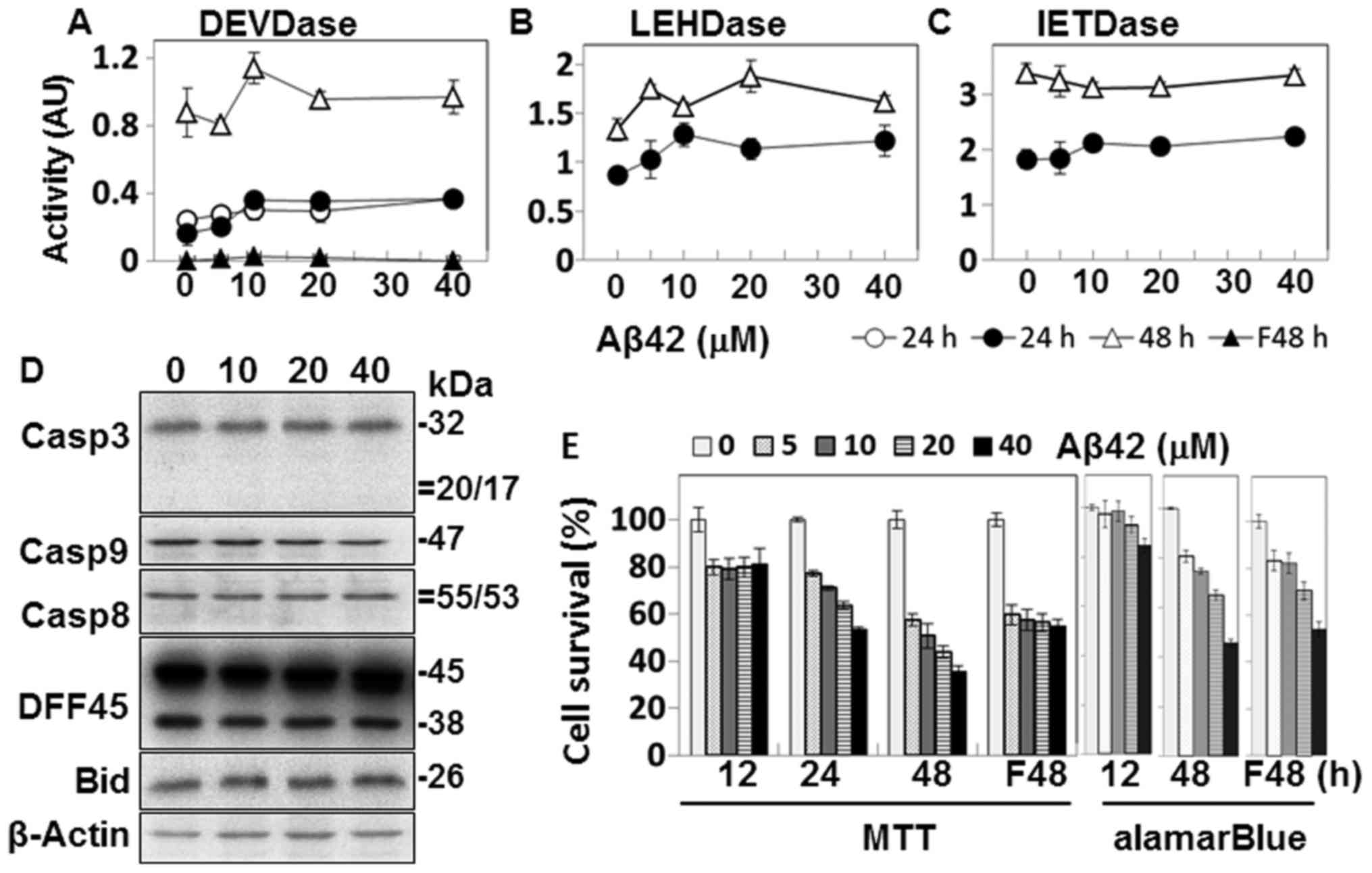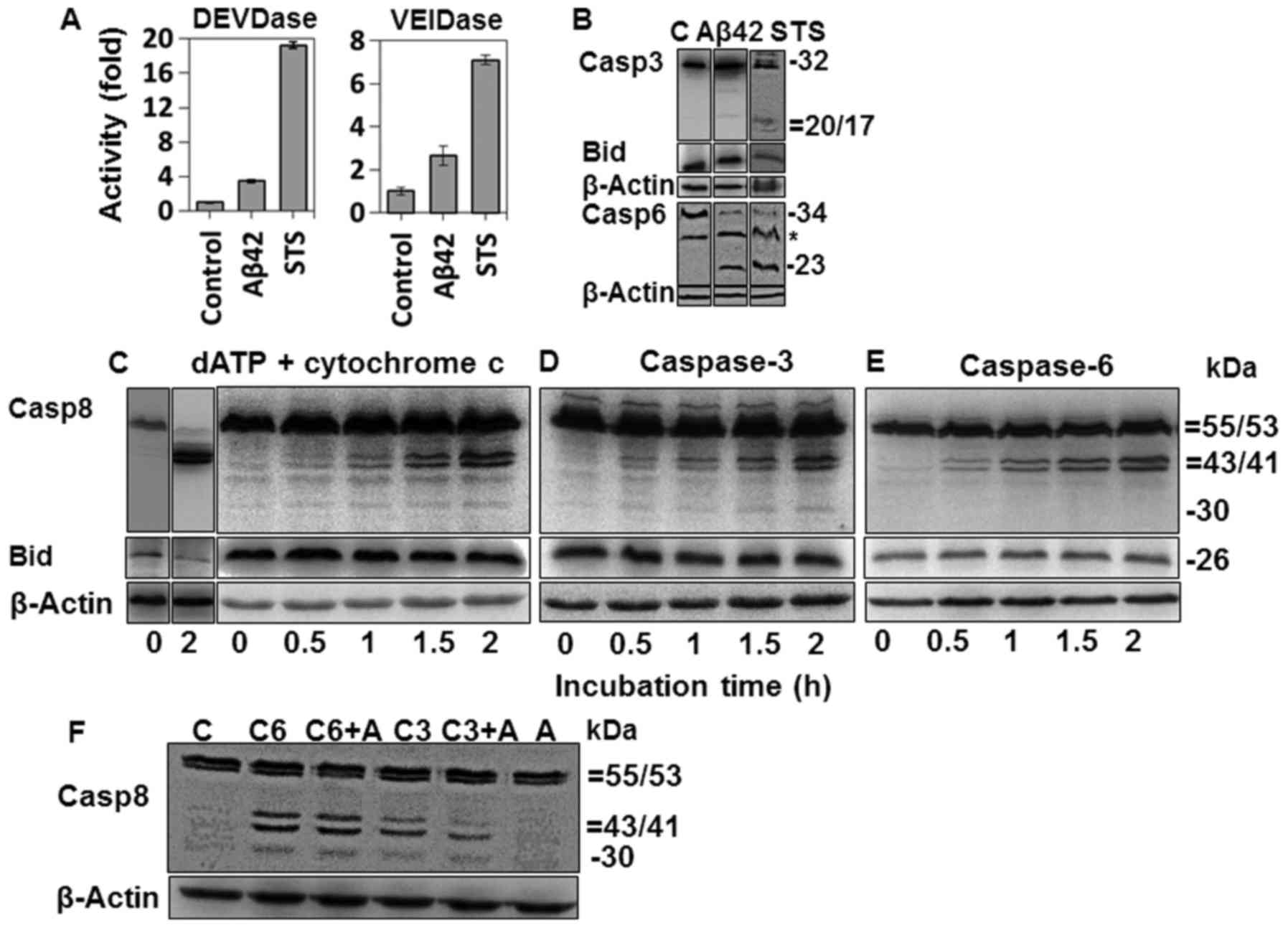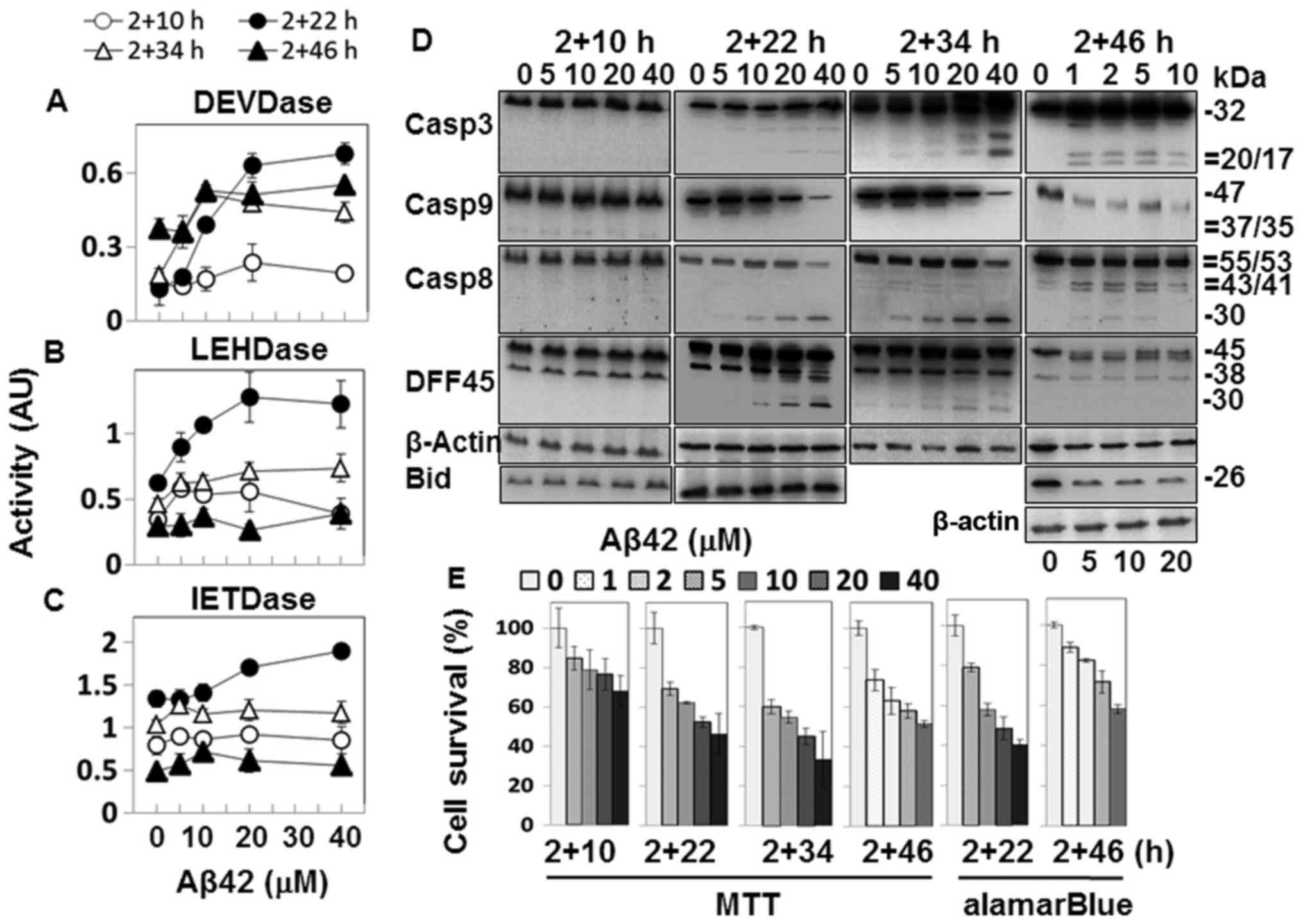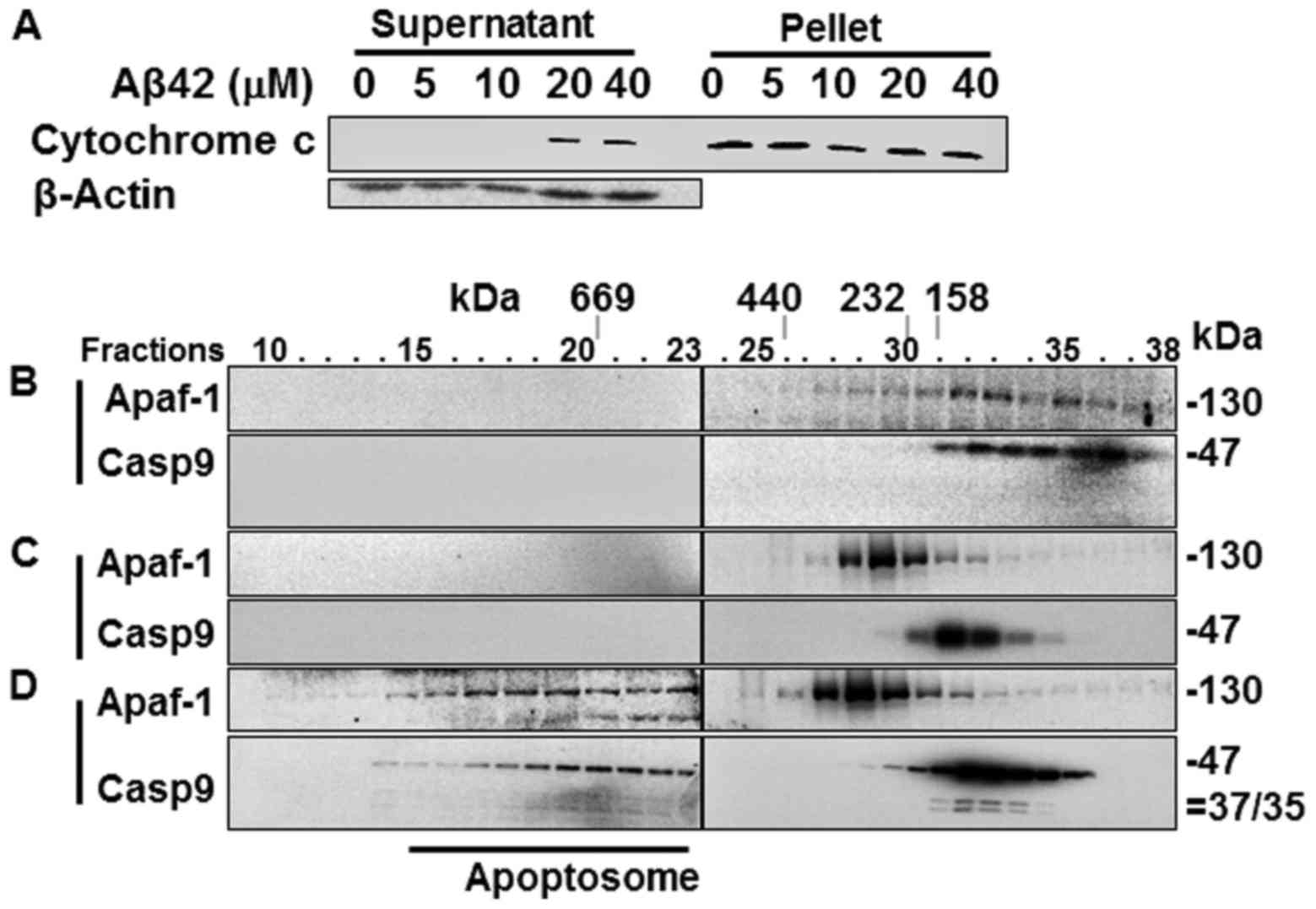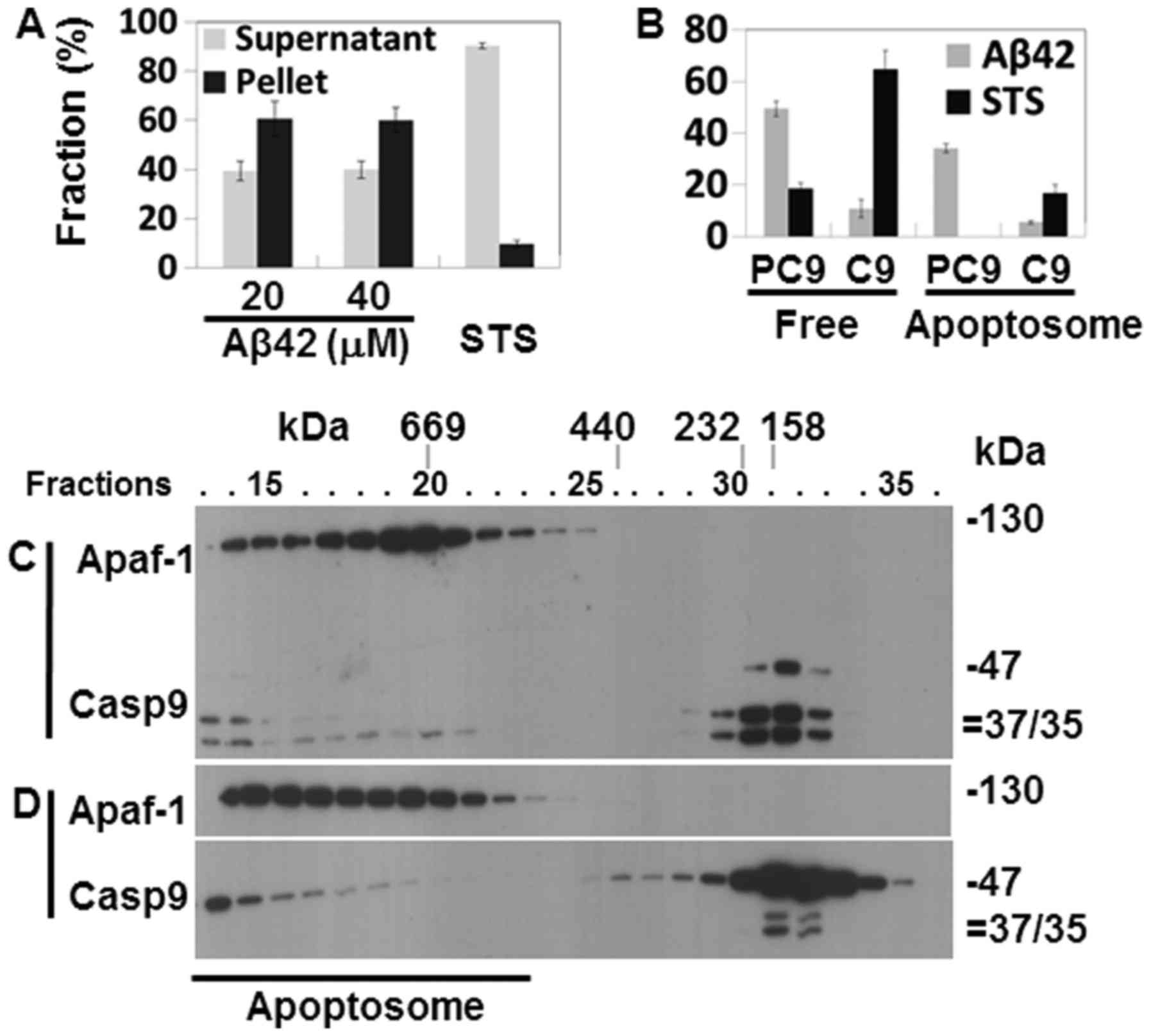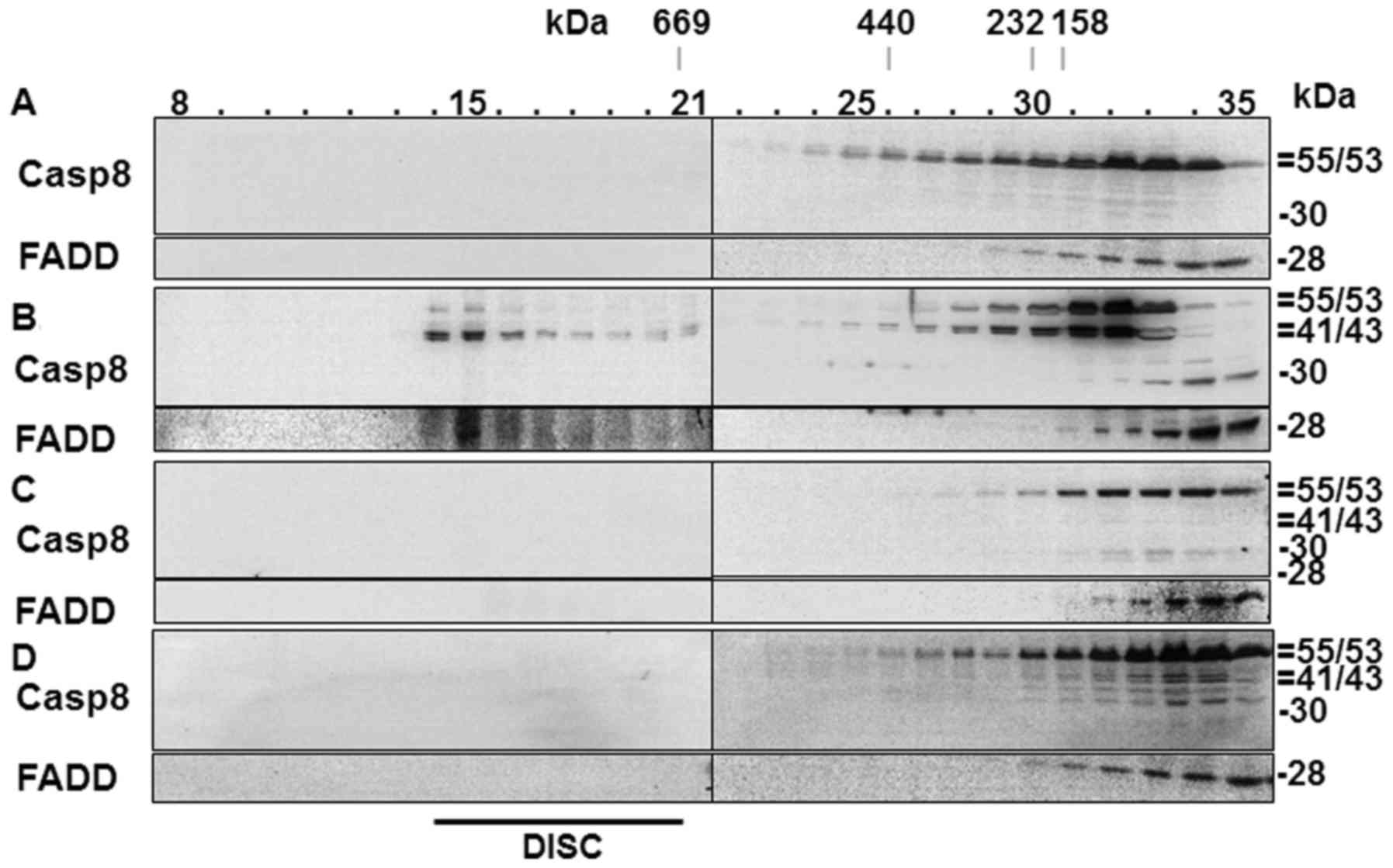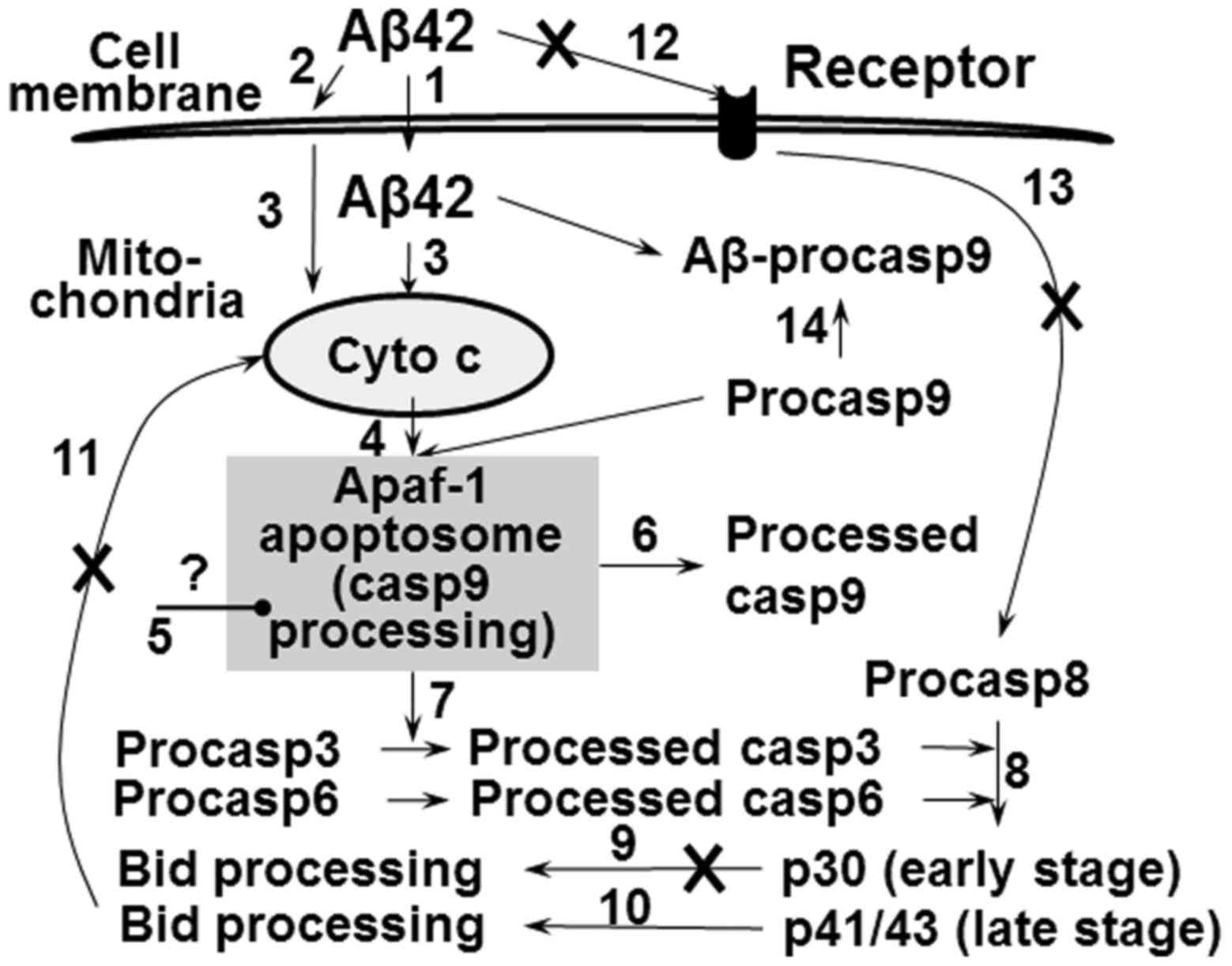|
1
|
Esler WP and Wolfe MS: A portrait of
Alzheimer secretases - new features and familiar faces. Science.
293:1449–1454. 2001. View Article : Google Scholar : PubMed/NCBI
|
|
2
|
Mattson MP: Pathways towards and away from
Alzheimer's disease. Nature. 430:631–639. 2004. View Article : Google Scholar : PubMed/NCBI
|
|
3
|
Hardy J and Selkoe DJ: The amyloid
hypothesis of Alzheimer's disease: Progress and problems on the
road to therapeutics. Science. 297:353–356. 2002. View Article : Google Scholar : PubMed/NCBI
|
|
4
|
Kayed R, Head E, Thompson JL, McIntire TM,
Milton SC, Cotman CW and Glabe CG: Common structure of soluble
amyloid oligomers implies common mechanism of pathogenesis.
Science. 300:486–489. 2003. View Article : Google Scholar : PubMed/NCBI
|
|
5
|
Neudecker P, Robustelli P, Cavalli A,
Walsh P, Lundström P, Zarrine-Afsar A, Sharpe S, Vendruscolo M and
Kay LE: Structure of an intermediate state in protein folding and
aggregation. Science. 336:362–366. 2012. View Article : Google Scholar : PubMed/NCBI
|
|
6
|
Selkoe DJ; American College of Physicians;
American Physiological Society: Alzheimer disease: Mechanistic
understanding predicts novel therapies. Ann Intern Med.
140:627–638. 2004. View Article : Google Scholar : PubMed/NCBI
|
|
7
|
Duyckaerts C, Delatour B and Potier MC:
Classification and basic pathology of Alzheimer disease. Acta
Neuropathol. 118:5–36. 2009. View Article : Google Scholar : PubMed/NCBI
|
|
8
|
Walsh DM, Minogue AM, Sala Frigerio C,
Fadeeva JV, Wasco W and Selkoe DJ: The APP family of proteins:
Similarities and differences. Biochem Soc Trans. 35:416–420. 2007.
View Article : Google Scholar : PubMed/NCBI
|
|
9
|
Chong YH, Shin YJ, Lee EO, Kayed R, Glabe
CG and Tenner AJ: ERK1/2 activation mediates Abeta oligomer-induced
neurotoxicity via caspase-3 activation and tau cleavage in rat
organotypic hippocampal slice cultures. J Biol Chem.
281:20315–20325. 2006. View Article : Google Scholar : PubMed/NCBI
|
|
10
|
Ellerby LM and Orr HT: Neurodegenerative
disease: Cut to the chase. Nature. 442:641–642. 2006. View Article : Google Scholar : PubMed/NCBI
|
|
11
|
Nikolaev A, McLaughlin T, O'Leary DD and
Tessier-Lavigne M: APP binds DR6 to trigger axon pruning and neuron
death via distinct caspases. Nature. 457:981–989. 2009. View Article : Google Scholar : PubMed/NCBI
|
|
12
|
Picone P, Carrotta R, Montana G, Nobile
MR, San Biagio PL and Di Carlo M: Abeta oligomers and fibrillar
aggregates induce different apoptotic pathways in LAN5
neuroblastoma cell cultures. Biophys J. 96:4200–4211. 2009.
View Article : Google Scholar : PubMed/NCBI
|
|
13
|
Fossati S, Ghiso J and Rostagno A: TRAIL
death receptors DR4 and DR5 mediate cerebral microvascular
endothelial cell apoptosis induced by oligomeric Alzheimer's Aβ.
Cell Death Dis. 3:e3212012. View Article : Google Scholar
|
|
14
|
Fossati S, Ghiso J and Rostagno A:
Insights into caspase-mediated apoptotic pathways induced by
amyloid-β in cerebral micro-vascular endothelial cells.
Neurodegener Dis. 10:324–328. 2012. View Article : Google Scholar
|
|
15
|
Boatright KM and Salvesen GS: Mechanisms
of caspase activation. Curr Opin Cell Biol. 15:725–731. 2003.
View Article : Google Scholar : PubMed/NCBI
|
|
16
|
Mace PD, Riedl SJ and Salvesen GS: Caspase
enzymology and activation mechanisms. Methods Enzymol. 544:161–178.
2014. View Article : Google Scholar : PubMed/NCBI
|
|
17
|
Troy CM, Friedman JE and Friedman WJ:
Mechanisms of p75-mediated death of hippocampal neurons. Role of
caspases. J Biol Chem. 277:34295–34302. 2002. View Article : Google Scholar : PubMed/NCBI
|
|
18
|
Truzzi F, Marconi A, Atzei P, Panza MC,
Lotti R, Dallaglio K, Tiberio R, Palazzo E, Vaschieri C and
Pincelli C: p75 neurotrophin receptor mediates apoptosis in
transit-amplifying cells and its overexpression restores cell death
in psoriatic keratinocytes. Cell Death Differ. 18:948–958. 2011.
View Article : Google Scholar :
|
|
19
|
Cha MY, Han SH, Son SM, Hong HS, Choi YJ,
Byun J and Mook-Jung I: Mitochondria-specific accumulation of
amyloid β induces mitochondrial dysfunction leading to apoptotic
cell death. PLoS One. 7:e349292012. View Article : Google Scholar
|
|
20
|
Murakami Y, Ohsawa I, Kasahara T and Ohta
S: Cytoprotective role of mitochondrial amyloid beta
peptide-binding alcohol dehydrogenase against a cytotoxic aldehyde.
Neurobiol Aging. 30:325–329. 2009. View Article : Google Scholar
|
|
21
|
Lee DY, Lee KS, Lee HJ, Kim DH, Noh YH, Yu
K, Jung HY, Lee SH, Lee JY, Youn YC, et al: Activation of PERK
signaling attenuates Abeta-mediated ER stress. PLoS One.
5:e104892010. View Article : Google Scholar : PubMed/NCBI
|
|
22
|
Verdier Y and Penke B: Binding sites of
amyloid beta-peptide in cell plasma membrane and implications for
Alzheimer's disease. Curr Protein Pept Sci. 5:19–31. 2004.
View Article : Google Scholar : PubMed/NCBI
|
|
23
|
Verdier Y, Zarándi M and Penke B: Amyloid
beta-peptide interactions with neuronal and glial cell plasma
membrane: Binding sites and implications for Alzheimer's disease. J
Pept Sci. 10:229–248. 2004. View Article : Google Scholar : PubMed/NCBI
|
|
24
|
Dahlgren KN, Manelli AM, Stine WB Jr,
Baker LK, Krafft GA and LaDu MJ: Oligomeric and fibrillar species
of amyloid-beta peptides differentially affect neuronal viability.
J Biol Chem. 277:32046–32053. 2002. View Article : Google Scholar : PubMed/NCBI
|
|
25
|
Resende R, Ferreiro E, Pereira C and
Resende de Oliveira C: Neurotoxic effect of oligomeric and
fibrillar species of amyloid-beta peptide 1-42: Involvement of
endoplasmic reticulum calcium release in oligomer-induced cell
death. Neuroscience. 155:725–737. 2008. View Article : Google Scholar : PubMed/NCBI
|
|
26
|
Thapa A, Woo ER, Chi EY, Sharoar MG, Jin
HG, Shin SY and Park IS: Biflavonoids are superior to
monoflavonoids in inhibiting amyloid-β toxicity and fibrillogenesis
via accumulation of nontoxic oligomer-like structures.
Biochemistry. 50:2445–2455. 2011. View Article : Google Scholar : PubMed/NCBI
|
|
27
|
Sharoar MG, Islam MI, Shahnawaz M, Shin SY
and Park IS: Amyloid β binds procaspase-9 to inhibit assembly of
Apaf-1 apoptosome and intrinsic apoptosis pathway. Biochim Biophys
Acta. 1843:685–693. 2014. View Article : Google Scholar : PubMed/NCBI
|
|
28
|
Thapa A, Shahnawaz M, Karki P, Raj Dahal
G, Sharoar MG, Yub Shin S, Sup Lee J, Cho B and Park IS:
Purification of inclusion body-forming peptides and proteins in
soluble form by fusion to Escherichia coli thermostable proteins.
Biotechniques. 44:787–796. 2008. View Article : Google Scholar : PubMed/NCBI
|
|
29
|
Chromy BA, Nowak RJ, Lambert MP, Viola KL,
Chang L, Velasco PT, Jones BW, Fernandez SJ, Lacor PN, Horowitz P,
et al: Self-assembly of Abeta(1–42) into globular neurotoxins.
Biochemistry. 42:12749–12760. 2003. View Article : Google Scholar : PubMed/NCBI
|
|
30
|
Karki P, Dahal GR and Park IS: Both
dimerization and inter-domain processing are essential for
caspase-4 activation. Biochem Biophys Res Commun. 356:1056–1061.
2007. View Article : Google Scholar : PubMed/NCBI
|
|
31
|
Wogulis M, Wright S, Cunningham D,
Chilcote T, Powell K and Rydel RE: Nucleation-dependent
polymerization is an essential component of amyloid-mediated
neuronal cell death. J Neurosci. 25:1071–1080. 2005. View Article : Google Scholar : PubMed/NCBI
|
|
32
|
Slaughter MR, Bugelski PJ and O'Brien PJ:
Evaluation of alamar blue reduction for the in vitro assay of
hepatocyte toxicity. Toxicol In Vitro. 13:567–569. 1999. View Article : Google Scholar : PubMed/NCBI
|
|
33
|
Karki P, Seong C, Kim JE, Hur K, Shin SY,
Lee JS, Cho B and Park IS: Intracellular K(+) inhibits apoptosis by
suppressing the Apaf-1 apoptosome formation and subsequent
downstream pathways but not cytochrome c release. Cell Death
Differ. 14:2068–2075. 2007. View Article : Google Scholar : PubMed/NCBI
|
|
34
|
Majkut J, Sgobba M, Holohan C, Crawford N,
Logan AE, Kerr E, Higgins CA, Redmond KL, Riley JS, Stasik I, et
al: Differential affinity of FLIP and procaspase 8 for FADD's DED
binding surfaces regulates DISC assembly. Nat Commun. 5:33502014.
View Article : Google Scholar : PubMed/NCBI
|
|
35
|
Estus S, Tucker HM, van Rooyen C, Wright
S, Brigham EF, Wogulis M and Rydel RE: Aggregated amyloid-beta
protein induces cortical neuronal apoptosis and concomitant
'apoptotic' pattern of gene induction. J Neurosci. 17:7736–7745.
1997.PubMed/NCBI
|
|
36
|
Xue WF, Homans SW and Radford SE:
Systematic analysis of nucleation-dependent polymerization reveals
new insights into the mechanism of amyloid self-assembly. Proc Natl
Acad Sci USA. 105:8926–8931. 2008. View Article : Google Scholar : PubMed/NCBI
|
|
37
|
Hoffmann JC, Pappa A, Krammer PH and
Lavrik IN: A new C-terminal cleavage product of procaspase-8, p30,
defines an alternative pathway of procaspase-8 activation. Mol Cell
Biol. 29:4431–4440. 2009. View Article : Google Scholar : PubMed/NCBI
|
|
38
|
Li H, Zhu H, Xu CJ and Yuan J: Cleavage of
BID by caspase 8 mediates the mitochondrial damage in the Fas
pathway of apoptosis. Cell. 94:491–501. 1998. View Article : Google Scholar : PubMed/NCBI
|
|
39
|
Oberst A, Pop C, Tremblay AG, Blais V,
Denault JB, Salvesen GS and Green DR: Inducible dimerization and
inducible cleavage reveal a requirement for both processes in
caspase-8 activation. J Biol Chem. 285:16632–16642. 2010.
View Article : Google Scholar : PubMed/NCBI
|
|
40
|
Pop C, Oberst A, Drag M, Van Raam BJ,
Riedl SJ, Green DR and Salvesen GS: FLIP(L) induces caspase 8
activity in the absence of interdomain caspase 8 cleavage and
alters substrate specificity. Biochem J. 433:447–457. 2011.
View Article : Google Scholar : PubMed/NCBI
|
|
41
|
Pop C, Fitzgerald P, Green DR and Salvesen
GS: Role of proteolysis in caspase-8 activation and stabilization.
Biochemistry. 46:4398–4407. 2007. View Article : Google Scholar : PubMed/NCBI
|
|
42
|
Salvesen GS and Dixit VM: Caspase
activation: The induced-proximity model. Proc Natl Acad Sci USA.
96:10964–10967. 1999. View Article : Google Scholar : PubMed/NCBI
|
|
43
|
Beaudouin J, Liesche C, Aschenbrenner S,
Hörner M and Eils R: Caspase-8 cleaves its substrates from the
plasma membrane upon CD95-induced apoptosis. Cell Death Differ.
20:599–610. 2013. View Article : Google Scholar : PubMed/NCBI
|
|
44
|
Qian MC, Liu J, Yao JS, Wang WM, Yang JH,
Wei LL, Shen YD and Chen W: Caspase-8 mediates amyloid-β-induced
apoptosis in differentiated PC12 cells. J Mol Neurosci. 56:491–499.
2015. View Article : Google Scholar : PubMed/NCBI
|
|
45
|
Hippe D, Lytovchenko O, Schmitz I and
Lüder CG: Fas/CD95-mediated apoptosis of type II cells is blocked
by Toxoplasma gondii primarily via interference with the
mitochondrial amplification loop. Infect Immun. 76:2905–2912. 2008.
View Article : Google Scholar : PubMed/NCBI
|
|
46
|
Cowling V and Downward J: Caspase-6 is the
direct activator of caspase-8 in the cytochrome c-induced apoptosis
pathway: Absolute requirement for removal of caspase-6 prodomain.
Cell Death Differ. 9:1046–1056. 2002. View Article : Google Scholar : PubMed/NCBI
|
|
47
|
Monnier PP, D'Onofrio PM, Magharious M,
Hollander AC, Tassew N, Szydlowska K, Tymianski M and Koeberle PD:
Involvement of caspase-6 and caspase-8 in neuronal apoptosis and
the regenerative failure of injured retinal ganglion cells. J
Neurosci. 31:10494–10505. 2011. View Article : Google Scholar : PubMed/NCBI
|
|
48
|
Slee EA, Harte MT, Kluck RM, Wolf BB,
Casiano CA, Newmeyer DD, Wang HG, Reed JC, Nicholson DW, Alnemri
ES, et al: Ordering the cytochrome c-initiated caspase cascade:
Hierarchical activation of caspases-2, -3, -6, -7, -8, and -10 in a
caspase-9-dependent manner. J Cell Biol. 144:281–292. 1999.
View Article : Google Scholar : PubMed/NCBI
|
|
49
|
Morishima Y, Gotoh Y, Zieg J, Barrett T,
Takano H, Flavell R, Davis RJ, Shirasaki Y and Greenberg ME:
Beta-amyloid induces neuronal apoptosis via a mechanism that
involves the c-Jun N-terminal kinase pathway and the induction of
Fas ligand. J Neurosci. 21:7551–7560. 2001.PubMed/NCBI
|
|
50
|
Jan A, Adolfsson O, Allaman I, Buccarello
AL, Magistretti PJ, Pfeifer A, Muhs A and Lashuel HA: Abeta42
neurotoxicity is mediated by ongoing nucleated polymerization
process rather than by discrete Abeta42 species. J Biol Chem.
286:8585–8596. 2011. View Article : Google Scholar
|
|
51
|
Wieder T, Essmann F, Prokop A, Schmelz K,
Schulze-Osthoff K, Beyaert R, Dörken B and Daniel PT: Activation of
caspase-8 in drug-induced apoptosis of B-lymphoid cells is
independent of CD95/Fas receptor-ligand interaction and occurs
downstream of caspase-3. Blood. 97:1378–1387. 2001. View Article : Google Scholar : PubMed/NCBI
|



